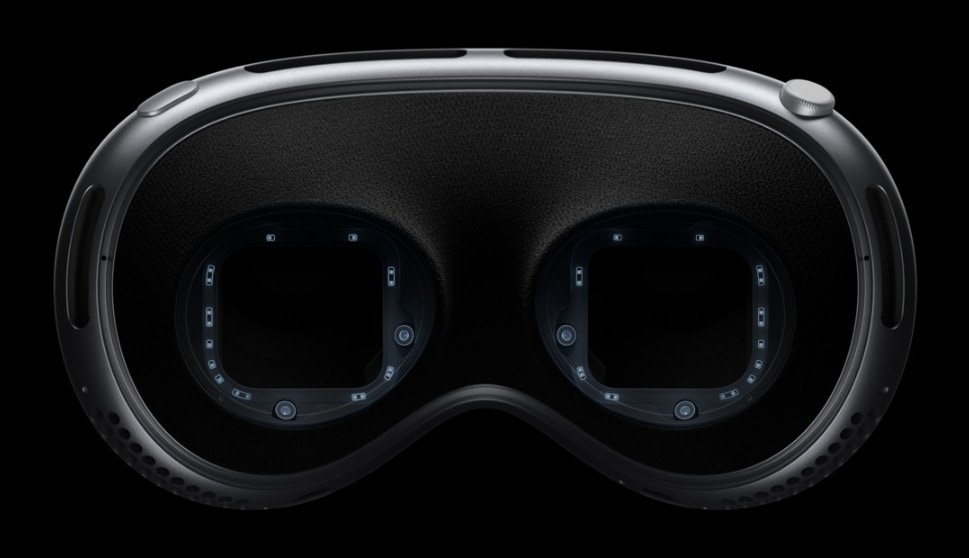When Apple unveiled its groundbreaking Vision Pro mixed reality headset, one feature that caught everyone’s attention was the unique authentication system called Optic ID. Unlike the brand’s popular Face ID and Touch ID biometrics, this method taps into the intricate patterns of your iris to securely unlock the futuristic wearable. Let’s take a deeper look at this (quite literally) eye-opening new tech.
Optic ID provides a seamless and secure way to authenticate yourself on the Vision Pro using the uniqueness of your iris patterns. Thanks to the headset’s high-precision eye-tracking system with infrared cameras and LED illuminators, a quick glance is all it takes to verify your identity.

With a single look, Optic ID can unlock your Vision Pro, authorise App Store and Book Store purchases, confirm Apple Pay transactions, and handle any other identity verifications. Developers can also allow it to handle sign-ins for their apps. If an app supports Face ID or Touch ID, it’ll work with Optic ID too.
Why did Apple need a new authentication method?
Like any other headset of this type, the Vision Pro has been designed to sit as close to your eyes as possible. Sure, there are inward-facing cameras, but they can only see the upper part of your head when you’re wearing the headset, which is obviously not enough to catch an accurate 3D face scan.
 Inward-facing sensors on the Vision Pro. (Image: Apple)
Inward-facing sensors on the Vision Pro. (Image: Apple)
However, the headset’s ideal positioning gives those infrared cameras and LEDs a stable, close-up view of your irises. So Apple’s innovators cooked up Optic ID to fill that authentication gap.
How does Optic ID work?
Apple has outfitted the Vision Pro with high-res cameras and illumination sensors to brilliantly capture the intricate patterns of your irises using invisible LED light exposures. This iris data is securely stored and encrypted by the headset’s Secure Enclave processor.
 (Image: Apple)
(Image: Apple)
When you attempt to authenticate, the cameras scan your iris again and this fresh capture is compared against your enrolled Optic ID data. If there’s a successful match, the Vision Pro unlocks instantly. Apple says that it uses sophisticated neural networks that analyse the authenticity of the iris and surrounding region to protect against spoofing.
Story continues below this ad
Optic ID vs Face ID and Touch ID
Of course, this isn’t Apple’s first foray into biometric user authentication. The Face ID facial recognition system and Touch ID fingerprint scanner have been security mainstays on iPhones and other Apple devices for years now.
So how does the newbie Optic ID compare? Well, it operates on a very different premise than Face ID’s 3D facial mapping and Touch ID’s fingerprint reading. Optic ID is all about those ultra-intricate, unique patterns in your eye that are almost impossible to spoof.
While Touch ID requires a physical sensor you have to deliberately touch and Face ID needs to see your full face, Optic ID just needs to catch a glimpse of your peepers to work its magic. That makes it a very natural, low-friction authentication experience for a head-mounted wearable device that’s always getting your eye in its sights.
Is Optic ID safe and secure?
 (Image: Igor Omilaev/Unsplash)
(Image: Igor Omilaev/Unsplash)
According to Apple, the probability of a random person unlocking your Vision Pro via Optic ID is less than 1 in 10,00,000, offering robust security. The system also permits only five unsuccessful match attempts before requiring a passcode.
Story continues below this ad
To address potential safety concerns, Apple claims the near-infrared illumination system used for iris scanning complies with international eye safety standards due to its low output intensity. So there’s no danger to your peepers.
What does the Optic ID setup process look like?
When you first set up your Vision Pro, you’ll be guided through the process of enrolling your iris patterns to enable Optic ID authentication. This involves looking around at various points so the headset can thoroughly capture your iris data. Once enrolled, you can designate Optic ID as your preferred way to unlock the headset, authorise payments, and more.
Could iPhones get Optic ID?
Optic ID is pretty cool, so it’s natural to wonder if Apple could bring iris scanning to future iPhones, too. But sadly, Apple has developed the tech specifically for the unique demands of the Vision Pro’s wearable form factor and there’s been no hint of plans to bring it to iPhones.
Plus, if Apple’s past behaviour is any indication, they seem pretty set on sticking with Face ID for the foreseeable future. Remember during the pandemic when despite all the COVID-19 mask issues, Apple doubled down on facial recognition instead of switching to Touch ID?
Story continues below this ad
 Apple doubled down on Face ID instead of switching to Touch ID during the pandemic. (Image: Apple)
Apple doubled down on Face ID instead of switching to Touch ID during the pandemic. (Image: Apple)
Rumours of under-screen fingerprint readers also used to swirl around once, but with Apple perfecting Face ID, they now seem more distant than ever. It’s clear that Apple’s other authentication methods are here to stay.
In the meantime, the Vision Pro will be letting us unlock our faces like space-age cyborgs.



 Inward-facing sensors on the Vision Pro. (Image: Apple)
Inward-facing sensors on the Vision Pro. (Image: Apple) (Image: Apple)
(Image: Apple) (Image: Igor Omilaev/Unsplash)
(Image: Igor Omilaev/Unsplash) Apple doubled down on Face ID instead of switching to Touch ID during the pandemic. (Image: Apple)
Apple doubled down on Face ID instead of switching to Touch ID during the pandemic. (Image: Apple)





